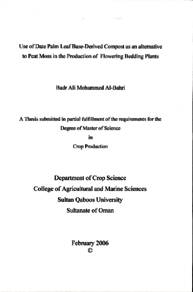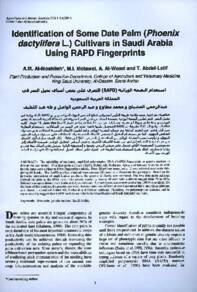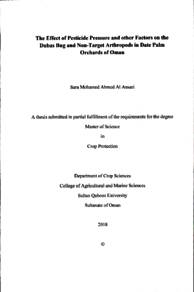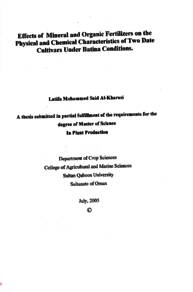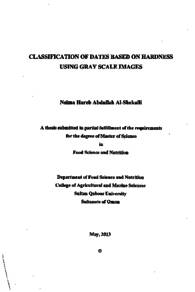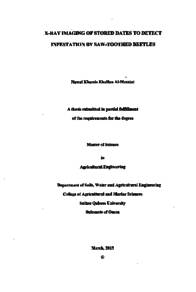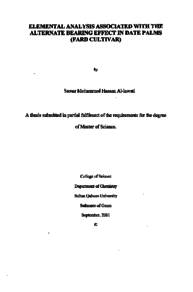وثيقة
Use of date palm leaf base-derived compost as an alternative to peat moss in the production of flowering bedding plants
الناشر
Sultan Qaboos University
ميلادي
2006
اللغة
الأنجليزية
الملخص الإنجليزي
ABSTRACT
Peat from date palm (Phoenix dactylifera) leaf bases was produced by a fermentaion ses was
process. Physical and chemical properties, such as pH, electrical conductivity (EC), macronutrient availability, total phenol and water holding capacity (WHC) of commercial peat moss (CP) and produced peats; fermented date palm leaf base peat (FLBP), dry date palm leaf bases peat (DLBP) and leached date palm leaf base peat (LLBP) were determined. The results showed no significant differences in most of the physical and chemical properties of peat mixes. All media mixes had pH and EC higher than CP, whereas, DLBP produced the higher total phenols than the other mixes, FLBP caused insignificant increase in WHC over CP and FLBP with CP, but significantly different from the remaining media. Produced peats from date palm leaf bases and CP were tested for their effects on the growth of some bedding flower vel plants: Zinna (Zinnia elegans) and Marigold (Tagetes erecta). There were no significant differences in plant height, number of leaves per plant, number of leaves per cm, number of flowers, growth rate and dry matter of shoot and root of Zinnia and Marigold plants in the potting media containing the CP and FLBP. In many casses, FLBP shown better results than CP. Also, date palm leaf base peat cost is lower than
the commercial peat moss by 63 %. Producing date palm leaf base peat has a friendly environment impact: it contributes to the disposal of large quantities of plant waste and reduces air pollution caused by burning palm leaves.
المجموعة
URL المصدر
الملخص العربي
الخلاصة
لقد تم إنتاج تربة صناعية زراعية (بيت) من كعوب سعف النخيل الجافة وذلك بطريقة التخمير والغسيل، وتمت دراسة الخصائص الطبيعية والكيميائية للتربة المصنعه مثل درجة الحموضة (pH) والتوصيل الكهربائي (EC) ونسب العناصر الرئيسية والفينول والسعة الإستيعابية للمياه ومقارنتها بالتربة المصنعة المستوردة (البيتموس) ووجد أنه لا توجد فروقات معنوية في معظم الخصائص المذكورة أعلاه بين الترب المستوردة والمخمرة ، وأظهرت النتائج إرتفاع في درجة الحموضة والتوصيل الكهربائي في كل الخلطات المصنعة مقارنة بالبيت التجاري ، بينما أعطت الخلطة الجافة أعلى فينولات كلية. وقد أدت البيت المخمرة إلى إرتفاع في السعة الإستيعابية للمياه عن البيت التجاري منفردا أو مخلوطا مع البيت المخمر. وقد تم زراعة نوعين من الحوليات الموسمية ( الزينيا والماريجولد) لمقارنة إرتفاع النبات وعدد الأوراق للنبات وعدد الأوراق لكل سنتيمتر وعدد الأزهار وكذلك نسبة المادة الجافة للساق والجذر والنسبة بينهما، ووجد أنه ليس هناك أي فروقات معنوية بين البيئتين في معظم الخصائص آنفة الذكر ، بل أنه في معظم الأحيان تكون الأفضلية للتربة الزراعية المخمرة والمصنوعة محلية من كعوب سعف النخيل ، كما أن تكلفة إنتاج التربة المصنعة محليا من النخيل تقل بحوالي 63 % عن التربة الصناعية المستوردة ، أضف إلى ذلك في حال إنتاج هذه التربة المصنعه من النخيل فسيتم تقليل التلوث الهوائي وذلك بسبب إستخدام اجزاء النخيل التي يتم حرقها في الوقت الحاضر.
لقد تم إنتاج تربة صناعية زراعية (بيت) من كعوب سعف النخيل الجافة وذلك بطريقة التخمير والغسيل، وتمت دراسة الخصائص الطبيعية والكيميائية للتربة المصنعه مثل درجة الحموضة (pH) والتوصيل الكهربائي (EC) ونسب العناصر الرئيسية والفينول والسعة الإستيعابية للمياه ومقارنتها بالتربة المصنعة المستوردة (البيتموس) ووجد أنه لا توجد فروقات معنوية في معظم الخصائص المذكورة أعلاه بين الترب المستوردة والمخمرة ، وأظهرت النتائج إرتفاع في درجة الحموضة والتوصيل الكهربائي في كل الخلطات المصنعة مقارنة بالبيت التجاري ، بينما أعطت الخلطة الجافة أعلى فينولات كلية. وقد أدت البيت المخمرة إلى إرتفاع في السعة الإستيعابية للمياه عن البيت التجاري منفردا أو مخلوطا مع البيت المخمر. وقد تم زراعة نوعين من الحوليات الموسمية ( الزينيا والماريجولد) لمقارنة إرتفاع النبات وعدد الأوراق للنبات وعدد الأوراق لكل سنتيمتر وعدد الأزهار وكذلك نسبة المادة الجافة للساق والجذر والنسبة بينهما، ووجد أنه ليس هناك أي فروقات معنوية بين البيئتين في معظم الخصائص آنفة الذكر ، بل أنه في معظم الأحيان تكون الأفضلية للتربة الزراعية المخمرة والمصنوعة محلية من كعوب سعف النخيل ، كما أن تكلفة إنتاج التربة المصنعة محليا من النخيل تقل بحوالي 63 % عن التربة الصناعية المستوردة ، أضف إلى ذلك في حال إنتاج هذه التربة المصنعه من النخيل فسيتم تقليل التلوث الهوائي وذلك بسبب إستخدام اجزاء النخيل التي يتم حرقها في الوقت الحاضر.
قالب العنصر
الرسائل والأطروحات الجامعية

